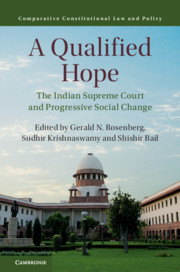Book contents
- A Qualified Hope
- Comparative Constitutional Law and Policy
- A Qualified Hope
- Copyright page
- Contents
- Notes on Contributors
- Foreword
- Acknowledgments
- Introduction
- Part I The Supreme Court of India – An Institutional Overview
- Part II The Supreme Court of India, Social and Political Mobilization
- Part III Welfare Rights and the Environment
- 9 A Case for Qualified Hope?
- 10 Implementation in the Delhi Pollution Case
- Part IV Discrimination
- Conclusion
- References
10 - Implementation in the Delhi Pollution Case
Lessons for the Future
from Part III - Welfare Rights and the Environment
Published online by Cambridge University Press: 19 August 2019
- A Qualified Hope
- Comparative Constitutional Law and Policy
- A Qualified Hope
- Copyright page
- Contents
- Notes on Contributors
- Foreword
- Acknowledgments
- Introduction
- Part I The Supreme Court of India – An Institutional Overview
- Part II The Supreme Court of India, Social and Political Mobilization
- Part III Welfare Rights and the Environment
- 9 A Case for Qualified Hope?
- 10 Implementation in the Delhi Pollution Case
- Part IV Discrimination
- Conclusion
- References
Summary
The Indian Supreme Court has become renowned for its policy making decisions, yet at the same time it has often confronted problems in implementation. A literature is developing around the question of which orders are implemented and why. This chapter adds to that literature using as a case study the Delhi Pollution Case and focusing on its most controversial aspect, the order for all public transport vehicles in Delhi to run on compressed natural gas. A confluence of factors came together in this case which it is argued explains its successful implementation. The crucial factor was intensive monitoring by the Court itself, which was supplemented by a series of facilitators that eased the Court’s burden. While this particular mix of factors and their interactions may infrequently reoccur, there are lessons to be drawn for enhancing the likelihood of implementation in future cases. The case also provides a warning. Focusing on implementation alone begs the question of the effectiveness of the Court’s broader policy making. Within five to ten years of the conversion to CNG, short term benefits to both the quality of Delhi’s air and public health had dissipated significantly.
Information
- Type
- Chapter
- Information
- A Qualified HopeThe Indian Supreme Court and Progressive Social Change, pp. 269 - 292Publisher: Cambridge University PressPrint publication year: 2019
